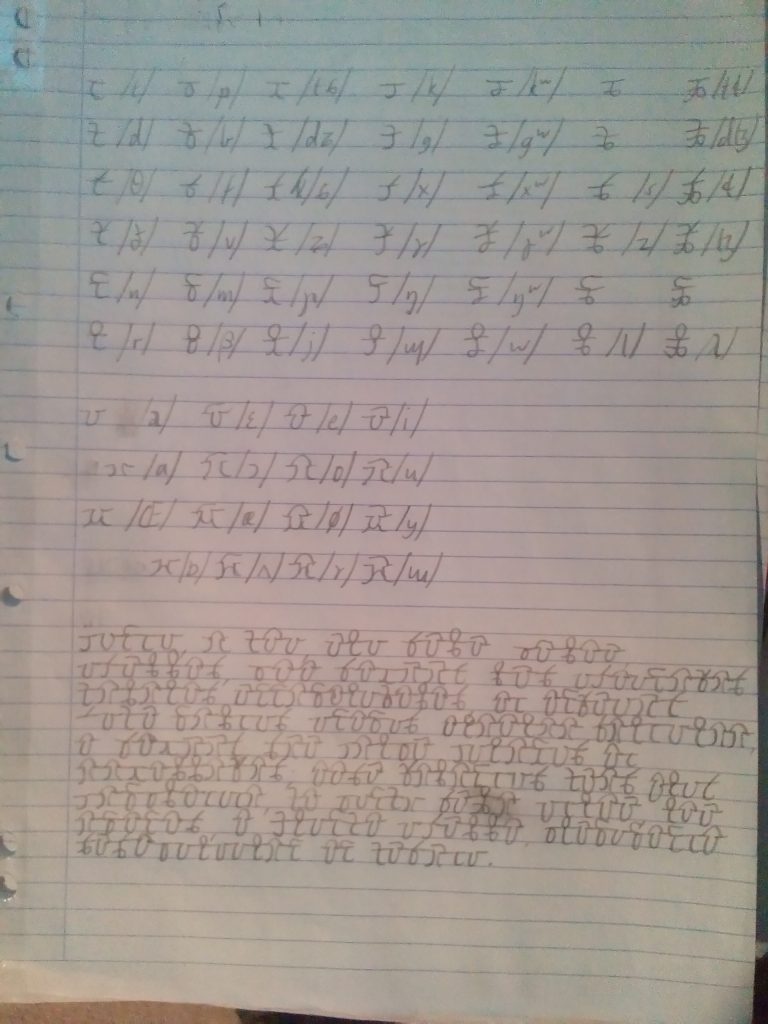As I mentioned in an earlier post, I am working on several conlangs for Innocence Seekers: The Black Rose. Of course, it won’t do to just work on a language; one would need to create an entirely new script for the language(s). This post will mention the writing systems in use in Innocence Seekers: The Black Rose, as well as detail one of my constructed scripts, the Nodaimese script.
There are a number of writing systems in use throughout the Innocence Seekers universe. By far the most widespread writing system is the Latin alphabet. Having originated as a script to write Latin, the massive influence of the Roman Empire has spread the script throughout Europe, and into Nodaima, and later, the colonial period saw a second expansion of the script. As of the events of Innocence Seekers: The Black Rose, it is used to write some of the lingua francas of the galaxy, including English and Nodaimese. There are many other scripts in use throughout the galaxy as well. In galactic communication, one can find the use of Cyrillic, Arabic script, Han characters, and many others I won’t mention.
Now, I will mention my constructed script. I’ve made it a featural alphabet, and while it is currently a work in progress, I’ve so far created 59 letters (43 consonant letters and 16 vowel letters). The following image is a list of letters in the alphabet, as well as sample of the Nillonan language (the same sample I used in the earlier mentioned post).
There are three sections in the image of my rough draft (I’ll convert them into a digital form later). The top section lists the consonants. They are identifiable by their straight unbroken horizontal line. The columns represent the place of articulation, while the rows represent the actual realisation of the letter. To aid in transcription, I’ve also listed the International Phonetic Alphabet (IPA) values alongside the letters. Note that of the 43 consonant letters, I’ve only assigned values to 39. The last two columns are “auxillary” dentals, whose actual sounds can be arbitrarily defined by the language (although the penultimate column’s values are well-established cross-linguistically); however, the rules regarding the manner of articulation (determined by the row) must be followed.
The columns represent the following:
- Dental/alveolar consonants
- Labial/labiovelar consonants
- Palatal consonants
- Velar consonants
- Labiovelar consonants
- First auxillary; other common consonants
- Second auxillary; laterals in Nodaimese
The rows represent the following:
- Voiceless stops or affricates
- Voiced stops or affricates
- Voiceless fricatives or aspirated stops
- Voiced fricatives or breathy voiced stops
- Nasals
- Approximants/flaps
One letter I haven’t listed is the letter for /h/. The column containing this letter I haven’t drawn as there wasn’t enough space for it. The column’s letter shape is simply a horizontal line, and /h/ is in the third row.
The middle section lists the vowels. They are identifiable by the fact that the horizontal line is altered within the letter. They’re currently unfinished; I’ve yet to determine the letter for central vowels. Regardless, the four columns represent the height of the vowel, from low to high. The rows represent the following:
- Unrounded front vowels
- Rounded back vowels
- Rounded front vowels
- Unrounded back vowels
The bottom section is a transcription of the Nillonan translation of the first seven lines of the Iliad. Note that words are set apart by breaks in horizontal lines (at where the lines end horizontally).
That will be all for now.
P.S. This is the fourth support illustration for Magic of Stella, drawn by Kaori Hanzawa (Comic Girls, Manga Time Kirara MAX). (2016-10-01) This is the fifth illustration, drawn by Hiroki Haruse (Mahō Shōjo no Karei-naru Yosei, Manga Time Kirara MAX; Adashino-san wa Sude ni Shinderu, Manga Life).
P.P.S. (2016-10-01) There is a spelling error on the fourth line of the bottom section; the last word should be “forterō”, not “fortarō”.
